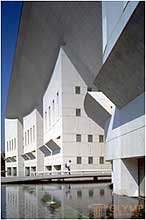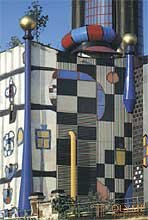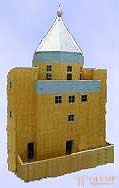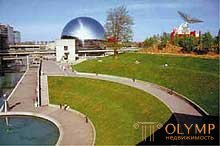
The ideological platform of deconstruction is the position of the modern French philosopher Jacques Derrida, who criticizes the metaphorical nature of all forms of modern European consciousness, which, in his opinion, consists in the principle of "being as presence" absolutizing the present time. Derrida sees a way out of this metaphysical character in finding its historical origins by analyzing / "deconstructing" / the most diverse texts of the humanitarian culture in order to identify supporting concepts and layers of metaphors imprinting traces of subsequent eras.
Although Derrida's worldview is based on his work with language and writing (the science of writing) he calls “grammatology” /, he applies the principles of his theory to the architecture of deconstructivism. 
In this respect, his evaluation of the project of the master plan of La Villett in Paris, arch. Bernard Moomin In the project of B. Chumi, the park is saturated with a scattering of light predominantly one- or two-story pavilions — foley — brightly painted metal structures, the compositions of which are based on combinations of images and techniques of the Russian avant-garde. Derrida writes that "foils contribute to the overall composition a sense of shift or displacement, involving in this process everything that until this moment seemed to give a sense to architecture ..." Foley is deconstructed primarily by the semantics of architecture. They destabilize the meaning, the meaning of the meaning. Will this not lead back to the desert of the “anti-architecture”, to the zero mark of the architectural language, at which it loses itself, its aesthetic aura, its foundation, its hierarchical principles? ..  No doubt not. Foley ... claim, maintain, update and "rewrite" the architecture. Perhaps they are reviving the energy that has been frozen, walled up, buried in a common grave of nostalgia. "
No doubt not. Foley ... claim, maintain, update and "rewrite" the architecture. Perhaps they are reviving the energy that has been frozen, walled up, buried in a common grave of nostalgia. "
Along with the foli, the principles and composition of a number of large buildings of the Parque la Villette are subject to the principles of decon. For example, in the 6-storey building of the City of Music "/ 1984-1990. Architect K. Portzampark / curvilinear reinforced concrete flooring" cut off "from the main body of the building and" hovers "above the glass stained glass window, filling the gap between the massive exterior walls and the floor The foli reception was repeated by German architects Schneider and Schummacher in the Infobox building / 1996 / at the Potsdamer Platz construction and reconstruction site in Berlin. This long red iron box was raised above the ground by three-heel steel pillars. Dean at the corner of the iron st The wall is destroyed and replaced by a large light blue stained glass window.The interior walls are separated from the ceiling by a wide / up to one meter / gap.The solution of a multi-storey residential building located in the center of Berlin at the corner of Koch and Friedrichstraß can serve as an example of German architecture. , near the ruined "Berlin Wall".  This 8-storey house was built by architect. P. Eisenman. A light green volume of a corner house with flat roofs typical for constructivism and large rectangular apertures contains such characteristic deconstructivism elements of the composition as trimming the corner of a building with consolidating two upper floors, introducing color onto the plane of the facade of three rectangular facing grids — white, gray and pink. different sizes of rectangular cells, which leads to sbivka scale and visual deconstruction of the building. The same non-material stained glass texture of the ground floor walls at the corners of the house serves as the same visual deconstruction. According to the author's plan, the first floor was to overlap with the Berlin Wall, for which it was coordinated with it in height / 3.3 m / and contained flat, deaf sections of external walls. However, this association has remained purely literary, figuratively not deterministic.
This 8-storey house was built by architect. P. Eisenman. A light green volume of a corner house with flat roofs typical for constructivism and large rectangular apertures contains such characteristic deconstructivism elements of the composition as trimming the corner of a building with consolidating two upper floors, introducing color onto the plane of the facade of three rectangular facing grids — white, gray and pink. different sizes of rectangular cells, which leads to sbivka scale and visual deconstruction of the building. The same non-material stained glass texture of the ground floor walls at the corners of the house serves as the same visual deconstruction. According to the author's plan, the first floor was to overlap with the Berlin Wall, for which it was coordinated with it in height / 3.3 m / and contained flat, deaf sections of external walls. However, this association has remained purely literary, figuratively not deterministic.
Interestingly, with the declaratively stated fundamental difference of creative programs, the compositional techniques of the masters of deon and postmodernism in design are often common. This position can be easily confirmed by comparing the decision of the above-described Eisenman’s house with the composition of a closely located / corner of Kochstrasse and Wilhelmstrasse / 7-storey building, built by the project of one of the leading masters of the postmodern - Aldo Rossi. As well as the first, this house occupies a responsible urban planning position, closing with its angular volume the prospects of intersecting streets and maintaining the representativeness of the adjacent buildings. Compositionally, the house is dissected into a series of roughly tangible cinnamon blocks by “intangible” 5-storey stained glass inserts. On the facades of the brick blocks, the scales of openings were cut over, color contrasts / red bricks, yellow belts, steel nacelled lintels / painted in intensive green color were actively used.  In the layout of the facade - typical for the deon "knocking down the scale" - the rows of ordinary apertures are interrupted by large two-storey apertures combining four windows of increased dimensions.
In the layout of the facade - typical for the deon "knocking down the scale" - the rows of ordinary apertures are interrupted by large two-storey apertures combining four windows of increased dimensions.
The main compositional “strike” is a deep and high / 4 floors / corner trim with the upper floors supported on a single column of hypertrophied section. The active compositional role of the pillar is underlined by its color - the white color contrasts with the red-brick facade.
In general, with all the variety of individual creative manners and creeds, the masters of Decon are based on the compositional motives of constructivism, but resort to some deformation / “distortion of abstraction” /, which gives their compositions dynamism and sharpness. Different deconstructivism authors select various periods and authors of the Russian avant-garde as sources.  So, for example, R. Koolhas and 3. Hadid in their work are focused on the late vanguard and especially on the "anti-gravity" architecture of I. Leonidov. R. Koolhas includes the composition of his dance theater in The Hague / 1984- 1987 / the volume of the overturned golden cone in which the restaurant is located, and 3. Hadid - the suspended volume with club rooms in the "Peak Club" competition for Hong Kong / 1983 city /. Other authors, on the contrary, are attracted by the dynamic architectural and pictorial compositions of the early avant-garde / H. Ladovsky, K. Malevich, V. Kandinsky, L. Popova / or balanced compositions by A. and V. Vesnins.
So, for example, R. Koolhas and 3. Hadid in their work are focused on the late vanguard and especially on the "anti-gravity" architecture of I. Leonidov. R. Koolhas includes the composition of his dance theater in The Hague / 1984- 1987 / the volume of the overturned golden cone in which the restaurant is located, and 3. Hadid - the suspended volume with club rooms in the "Peak Club" competition for Hong Kong / 1983 city /. Other authors, on the contrary, are attracted by the dynamic architectural and pictorial compositions of the early avant-garde / H. Ladovsky, K. Malevich, V. Kandinsky, L. Popova / or balanced compositions by A. and V. Vesnins.
Что бы оставить комментарий войдите
Комментарии (0)